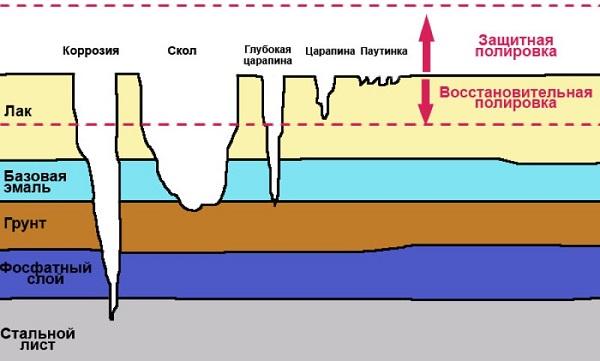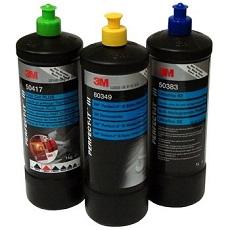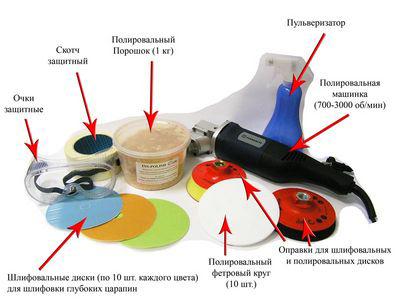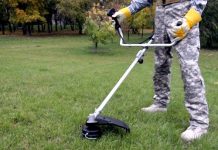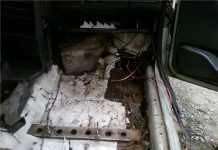For any car owner, his vehicle is an object of adoration, for the maintenance of which very significant funds are spent, and any scratch on the paintwork is perceived as very painful. This is largely due to the high cost of the new car, and a significant decrease in its selling price, even with minor defects on the body. If you do not take preventive measures to protect the body immediately after purchasing a new car, it is very likely that small scratches or chips will soon appear, spoiling the appearance of any car.
These measures include, for example, treating the body of a new car with liquid glass, which effectively prevents any mechanical damage to the paintwork. If it was not possible to avoid the appearance of scratches, in no case should they be left "as is". This is not just a cosmetic defect, since dirt, water and chemicals from the road that penetrate through the damage can lead to the formation of centers of body corrosion, which can sometimes be stopped. At the same time, it is far from always necessary to drive a car to a service station, modern means allow you to cope with shallow scratches and chips on your own.
Scratches on cars appear regardless of the driver's accuracy, and the main reasons for their occurrence are:
Particularly serious consequences for a car are scratches received in the winter, which is associated with the constant ingress of water with dissolved reagents into them, provoking the rapid appearance of corrosion.
Most of the existing self-removal products for minor damage to paintwork are effective only on scratches that affect only the paintwork. Many tools are no longer able to cope with paint damage. A relatively new product on the domestic market is the fix it pro scratch remover pencil, designed to effectively remove deep scratches and prevent the slightest signs of corrosion from developing at the site of damage. The video shows how simple and effective this method is.
VIDEO
A pencil for painting scratches on a car can contain various color pigments, so it is easy to match its color to almost any car model. Thanks to the carefully calibrated composition, the pencil perfectly fills the existing scratch or chip from scratches, even if they differ in considerable depth. This high efficiency is achieved by using a special base, usually acrylic, which, after application, hardens under the influence of UV rays.
A modern pencil for touching up scratches on a car is distinguished not only by its efficiency, but also by its extremely careful attitude to intact paintwork. Unlike standard products, for example, polishes, which, when applied, “remove” a certain layer of paint surrounding the scratch, the pencil “works” exclusively in the damaged area, without affecting entire areas.
Other benefits of a scratch remover from a car should also be mentioned:
a waterproof formula that is not afraid of the constant ingress of water, salt and other chemically active substances;
the absence of toxic substances makes working with it safe for humans;
the similarity of the structure of the pencil and the paintwork of the car makes the scratch completely invisible;
high degree of protection against possible corrosion;
ease of independent use;
high drying speed in direct sunlight;
resistance of the hardened compound to vibration and mechanical stress;
acceptable cost, incomparable with payment for car service.
A pencil for removing scratches on a car, according to car owners, is capable of removing even deep enough damage with high efficiency. For example, one of the reviews of a person who first used such a tool - “I succumbed to my wife’s persuasion to go to rest in the forest, not far from my own dacha. There are practically no roads there; as a result, the right side of the car was scratched by branches of either wild rose or spruce. I decided to use a scratch pencil, acquired on occasion and lying in the glove compartment. We returned to the city in a car that didn't have a single scratch. " by the way, in the comments to this article, you can easily leave your own feedback on the experience of using such restoration pencils.
To get a good result when using a pencil on your own to remove scratches on a car, you should pay attention to the quality of the preliminary surface preparation. The area of the vehicle where the damage is located must be thoroughly washed with soapy water. After that, it must be washed off with a large amount of clean warm water so that there are no traces of detergent left in the scratch - this parameter is critical enough to obtain a good result.
After cleaning, the surface must be properly dry. Do not use fluffy fabrics for this, since the remaining fine fibers will reduce the adhesion of the repair compound to the paint. You can force the drying procedure with an ordinary household hair dryer. Before using the pencil to remove scratches, you will need to shake it thoroughly for a few minutes. After that, you should lightly press on it - a corrective composition should appear at the tip.
Depending on the design features, the scratch removal pencil can be completed with either a special applicator rod or a brush. It is necessary to apply the composition in a small amount, distributing it in an even layer over the entire surface of the chip. If during the first application it was not possible to fill the entire flaw entirely, the treatment will need to be repeated. Excess corrector on the intact paintwork should be immediately removed with a napkin.
Many car owners treat scratch crayons with a certain degree of distrust, preferring to use polishing pastes. They contain a fine abrasive, due to which a small layer of varnish is removed along with damage. But the use of pastes has one caveat - they are effective only on surface scratches located on the varnish layer. In addition, it is not always possible to select the correct grain size - it is different for each paste.
Wax sticks are also not the best remedy for damage, because over time it simply leaches out of the scratch, which is facilitated by chemicals on the road, as well as visits to contactless car washes. Scratch paint has proven to be the most sought after and effective paint repair tool.
The following review, which was found on one of the thematic forums, also testifies to the high efficiency of a pencil on a car - “until recently, the only way for me to remove scratches from the body of my car was a wax pencil, but they had to handle scratches almost every couple of months. On the advice of a friend, I tried a new pencil from chips - I'm incredibly satisfied, not a trace of them remained, I've been skating for more than six months, the effect lasts, and the color matched the tone. "
Despite the relative safety that distinguishes all modern auto pencils, it is advisable to follow standard precautions when working with them.
Store the scratch patching pencil on the car only in places that children cannot reach.
The contact of the corrective composition on the skin is undesirable, especially for persons suffering from allergic reactions - in this case, it should be immediately washed off with warm soapy water.
Contact with the eyes is a reason for immediate medical attention.
It is undesirable to inhale the vapors of a pencil for painting scratches on the car, therefore, it is better to work outside, or if there is good supply and exhaust ventilation.
Most of the car pencils for scratches on the market have a small volume, and this is far from coincidental. After the first opening, it is advisable to use it as much as possible, since the remaining product can simply dry out. To store the pencil after use, you will need to very tightly close the existing cap, and also additionally wrap it with electrical tape.
Repair of chips and scratches on the car body: which method to give preference
DIY repair of scratches, chips on the car body
Work on paint chips
Stages of repairing a scratch or chip on the body
Materials for the repair of scratches and chips on the car body
Budget calculation
This moment is quite unpleasant for the car owner, not only because the car loses its aesthetic appearance, but also because it is in the places of scratches and chips that corrosion and rust begins to develop.
Therefore, it is very important to get rid of such small damage as soon as possible, since delaying the repair will lead to even greater monetary costs. You will learn how to independently remove scratches and small chips on the car body from this article.
One of them is polishing the body surface. This work can only be done when the scratch has not reached the ground level. For polishing, you need special pastes that will help remove a thin layer of paint in the place of the scratch and level it down to one level.
In this case, it must be remembered that the car is not painted, but on the contrary, a layer of paint is removed. This will require accuracy and care, because you can overdo it and polish to a layer of soil. Then you will have to paint not only the scratch, but the entire polishing place. And this will lead to additional costs of money and time.
It should be remembered that before using a wax pencil, the car must be thoroughly washed, and the place of the scratch must be cleaned with gasoline or white spirit. Removing a scratch with a wax crayon is fairly straightforward. If the scratch has not touched the layer of soil, but itself is very wide, here you will not get off with polishing and a wax pencil.
In any case, you have to paint. Only a scratch will be enough to paint. To do this work, you can glue the scratch on both sides with adhesive tape or masking tape.To apply paint, you can use a brush with which girls paint their nails. The main thing is to thoroughly rinse it in acetone and thin it out a little.
If the scratch has touched a layer of soil, there are also two possible solutions to this problem. The first is only suitable for very thin and small scratches. It consists, as in the previous case, in covering up scratches with a wax pencil. Again, do not forget about the preliminary treatment of scratches and washing the car. But don't flatter yourself. This method has one big drawback.
Over time, the wax layer will begin to fade, and the scratch will become more visible. Therefore, this treatment will have to be performed over and over again at some intervals and, in order to avoid this, it is best to touch up the scratch site. In this case, two layers of paint are applied after preliminary preparation.
If you notice a wide scratch that has reached the ground - forget about the wax pencil, it will not help in this matter. Here, only painting the damage site will help out.
For this, the place of the scratch must be washed and treated, as mentioned above, with gasoline or white spirit. Then it does not hurt to glue the problem area with adhesive tape around the perimeter and apply two layers of paint. This method is much more reliable and effective than a wax pencil, and it is done only once, unlike the first.
What if the scratch went through the top coat of paint, the primer coat and got to the metal? Although this damage is one of the most unpleasant, there are also ways to repair it. Here you will not get off with ordinary painting, and even more so with a wax pencil. First of all, as in all cases, the car should be thoroughly washed with foam and dried.
Then the standard process is processing with white spirit or gasoline. ... After that, wipe the car again in the place of damage, first with a damp and then with a dry cloth. If elements of corrosion are already visible in the place of the scratch, the next step will be the application of an anti-corrosion primer.
This element must never be omitted, as painting a deep scratch without anti-corrosion primer may lead to unexpected results.
Corrosion and rust will continue to develop under the paint layer, and will soon nullify all your efforts.
Sometimes car owners have parking problems, in which bumpers very often suffer. Therefore, scratches on bumpers are a fairly common problem that cannot be ignored.
The plastic bumper is not susceptible to corrosion and rust, so everything is simple here - cleaning from dirt, processing with gasoline and touching up with acrylic varnish from a repair can or paint.
If your car has metallic paint - everything is the same with one small feature. It consists in the fact that such a painted layer has a slightly higher gloss, which sometimes becomes very noticeable. To eliminate this problem, the painted area is covered with a thin layer of varnish.
We sorted out the scratches, but there is another common problem with the car body - paint chips. Chips of paint, even at a shallow depth, have a fairly large area, so a wax pencil is not used here.
If the depth of the chip is small, treatment of the problem area with a color-enriching polish can help, after which a layer of protective polish is applied.
Before processing, the surface should be cleaned and degreased. In the case when the chip has reached a layer of soil or metal, the polish is useless, and tint of the chip cannot be avoided. Some car owners are faced with the problem of bloated paint.
The damage is quite unpleasant, since under these swellings, foci of rust and corrosion appear. Therefore, this problem must be dealt with immediately. To do this, carefully open the bottle and remove any remaining paint.
You should remove so much that the remaining paint adheres securely to the car body. If, after opening the bubble, you find traces of corrosion or rust under it, it is imperative to remove it and treat the place with anti-corrosion primer.
Then you can start painting. The paint is applied in several layers so that it is equal in level with the old layer.
We thoroughly clean the place of the defect from dirt, traces of rust, if any. We make stripping to the ground. Degrease.
During troubleshooting, you decided what kind of primer you need: for paint or for metal. Apply a primer with a rubber spatula and let it dry. Then we clean up the area again.
That is, all procedures are performed in accordance with the body painting technology, only on a small area.
Before applying paint to the repair site, cover the surrounding surface of the body part with film or paper and masking tape. Apply paint from a spray can in accordance with the instructions.
If you use a "pencil" to repair a scratch or chip, then apply the paint in two or three layers. Do not immediately remove the resulting influx ... Let the paint dry.
After repairing a chip or scratch in the body and complete drying of the paint, polish the body at the place of repair. Given that the damage area is small, the body can be polished without the use of equipment, i.e. manually.
If you have too large a scratch area on the car body, the repair, most likely, will have to be done to the entire body part. Here already one "pencil" is indispensable.
In the same way, the repair of plastic parts is carried out with the only difference that the means for plastic surfaces are used.
On the shelves of the store, you can find a repair kit to restore the surface of the car. In its simplest form, these are several cans of paint, supplemented with consumables.
Kits are more expensive and include brushes, sandpaper, varnish, masking tape and other accessories. Stores often offer paint tinting to match the desired tone. Repair kits for severe chips contain primer, putty and tools to work with them.
Corrosion treatment compounds can sometimes be found in kits. Anti-corrosion mastic is ideal for car repairs with significant paintwork damage. The last finishing can be carried out not only with varnish, but also with special means that increase the reflectivity of the paint.
The main reasons for the formation of defects are small stones and road sand.They leave multiple but slight scratches. When diagnosing a car, it is necessary to assess their size and penetration depth.
A matte surface means that only the varnish has been damaged. White body - damage to paint or even soil. The budget will be affected not only by the "depth" of the work, but also by the speed of reaction.
Scratches that have reached the metal require immediate repair. The ideal driver should keep wax crayons close at hand and repair any dangerous damage as it is found. Timely cosmetic work will save money in the future. Approximate guidelines for determining costs:
- Fix it PRO and New Fix - sets of several pencils, from $ 0.15 to $ 2 excluding shipping.
- Single pencil Fix it PRO (Car Repair Pen) - $ 0.1.
- 5X and 5Pcs - Multiple scratches, price up to $ 7.
- 3M Scratch Remove - deep damage, up to $ 15.
If you decide to carry out a full cycle of priming and painting, then the main source of savings will be attentiveness. Do not skimp on materials, do not thin the varnish too much - it may leak.
Paint smudges are formed due to the high humidity in the room. For the same reason, do not use the car until it is completely dry.
Scratches on the paintwork of a car appear not only during emergencies and traffic accidents, but also during normal daily use of the car. Such defects affect not only the durability of the machine, but also the appearance of the vehicle. For these reasons, scratch removal remains a hot topic for car drivers.
Scratches on a car come in different lengths and depths. Depending on these factors, the following types are distinguished:
Such damage lends itself to removal with the help of only one polishing, since with such defects only the lacquer, surface layer is affected.
Scratches with depth of damage reaching the base of the paintwork.
In the case of an average degree of damage, repair is indispensable, but it is possible to correct such defects with the help of local actions.
Damage that has reached the metal, often with deformation of the car part and / or the appearance of rust.
The most severe type of defects, in which the layers of varnish, paint, primer and even metal are damaged, need serious repairs with preliminary straightening of the crumpled part and restoration of the primer layer.
Let's find out how to determine the depth of scratches on the door or other parts of the car:
Take water and a rag.
Pour water over the damaged surface and wipe with a dry cloth.
Take a close look at the scratch. If for some time it has taken the color of the car, the damage is on the lacquer coating. In this case, you can get by with a simple polishing of the body. If, when handling water, the color of the scratch remains unchanged, then the damage to the body is deep, possibly down to metal.
If a car enthusiast scratches the car and the damage is shallow, then you need to know how to get rid of the scratch on the car yourself. When a defect is found on a plastic car part, it can be removed by:
heating the surface with a building hair dryer or other heating device;
polishing;
a special pencil for removing scratches;
primers and stains.
The latter method of removing damage is used to get rid of deep scratches.
The usual dirty stains, which are removed after several washes, may seem like shallow damage on the plastic part of the car. If this does not happen, use a construction or regular hair dryer. While gradually heating the scratched surface, use the included hair dryer directly over the damaged areas.
To remove minor scratches on the car body, you must use special means to remove them.A special pencil (grout) will do, which will completely mask the damage. Before starting work, the surface should be cleaned of dirt, degreased with White Spirit or another similar agent (gasoline, thinner) and allowed to dry.
If dirt remains in the scratch, gently walk over it with a piece of sandpaper, not pressing it hard to the surface.
When holding a pencil over a scratched surface, the damage is filled with an elastic compound - acrylic paint. If a colored coating (paint) is touched, it is better to select a pencil of a suitable color and shade. After grouting the scratch, remember to polish the surface with a buffing machine. After the procedure, it is advisable to remove excess wax with a microfiber cloth.
Removing shallow defects can also be done with abrasive polishing. However, this method cannot be used more than four times. The 20 micron lacquer surface is removed in this way in 4 treatments. Thus, by polishing, you can hide not very deep defects in the paintwork yourself, which have affected the top layer and have reached a maximum of the base enamel.
To get rid of deep scratches on the body, you will need the following materials and tools:
sandpaper (P1500 and P2000);
primer mass (primer);
polish;
paint of the desired tone (to obtain an accurate color, it is recommended to carry out computer diagnostics).
During the operation of the car, the paintwork of the body tends to fade and wear off, therefore the color of the new car differs from the color of the used car.
VIDEO
Before carrying out restoration work, you need to check whether all materials have been prepared. If there is a two-component paint in the case of a metallic or a special pearlescent color of a car, mix the paint with the activator in the proportions specified on the package.
Let's figure out in stages how to remove a deep scratch on a car with our own hands:
Remove dirt from the surface to be repaired using rags, water, detergent and sandpaper.
If the appearance of a scratch to metal was accompanied by the formation of rust, sandpaper should be used to remove it. If there are dents and deflections in the metal, this place should first be eliminated using a special polyester putty for cars, the layer of which should not be more than three millimeters. After the substance has dried, the treated place of damage should be thoroughly rubbed, first with coarse-grained, and then with fine-grained sandpaper, making the surface differences invisible.
In the third step, you need to treat the scratch with a primer. Cover the damage with a brush or spray.
Allow the applied primer to dry and sand.
The surface is degreased.
Apply the prepared car enamel. It is more correct to paint the damage with a special spray gun.
Repairing scratches on a car involves the application of two or three coats of paint at intervals of half an hour.
Wait until the superimposed layer of car enamel is completely dry. This takes about 24 hours.
If you cannot remove scratches and eliminate defects on the surface of the car on your own, you need to contact a car service. Before sending the car for repairs, it is recommended that you first find out the prices for such services. It is possible that you will first have to show the car to the craftsmen to assess the condition of the car.
If there is such an opportunity, it is better to immediately bring the car for repair to a specialized organization. Otherwise, with the wrong approach, the treated body parts may swell or, conversely, "fall through". In case of insufficient removal of rust and its incorrect processing, its further development can occur, which leads to corrosive phenomena, which gradually destroy the car body.
The help of specialists from an automobile repair shop should be resorted to if repairs are required not only for metal parts of the body, but also for plastic parts. It is not easy to overhaul plastic panels or plastic bumpers. When heating these structural parts of the car, you can damage the surface even more without getting rid of the scratch.
Video (click to play).
Methods for removing damage from car surfaces depend not only on the area of the defect, but also on their nature, as well as on the depth of the scratches. Before starting repair work, you should find out how badly the coating is damaged. The success of the entire repair operation as a whole will depend on the correct formulation of such a "diagnosis".

